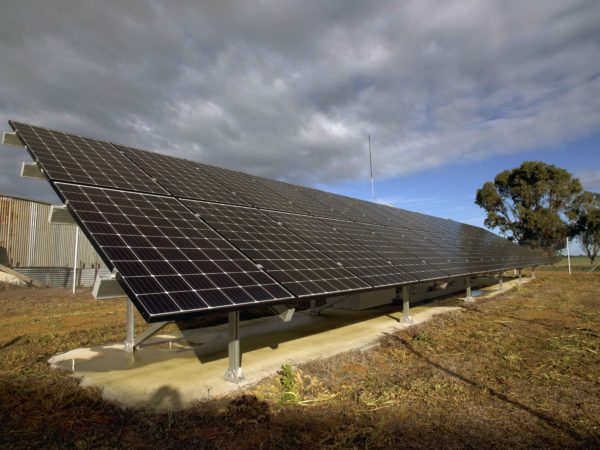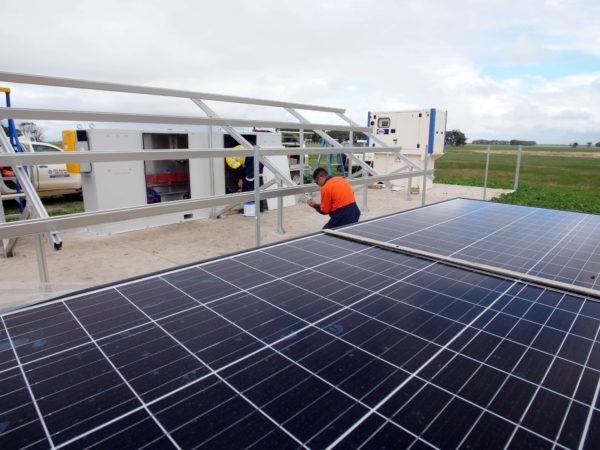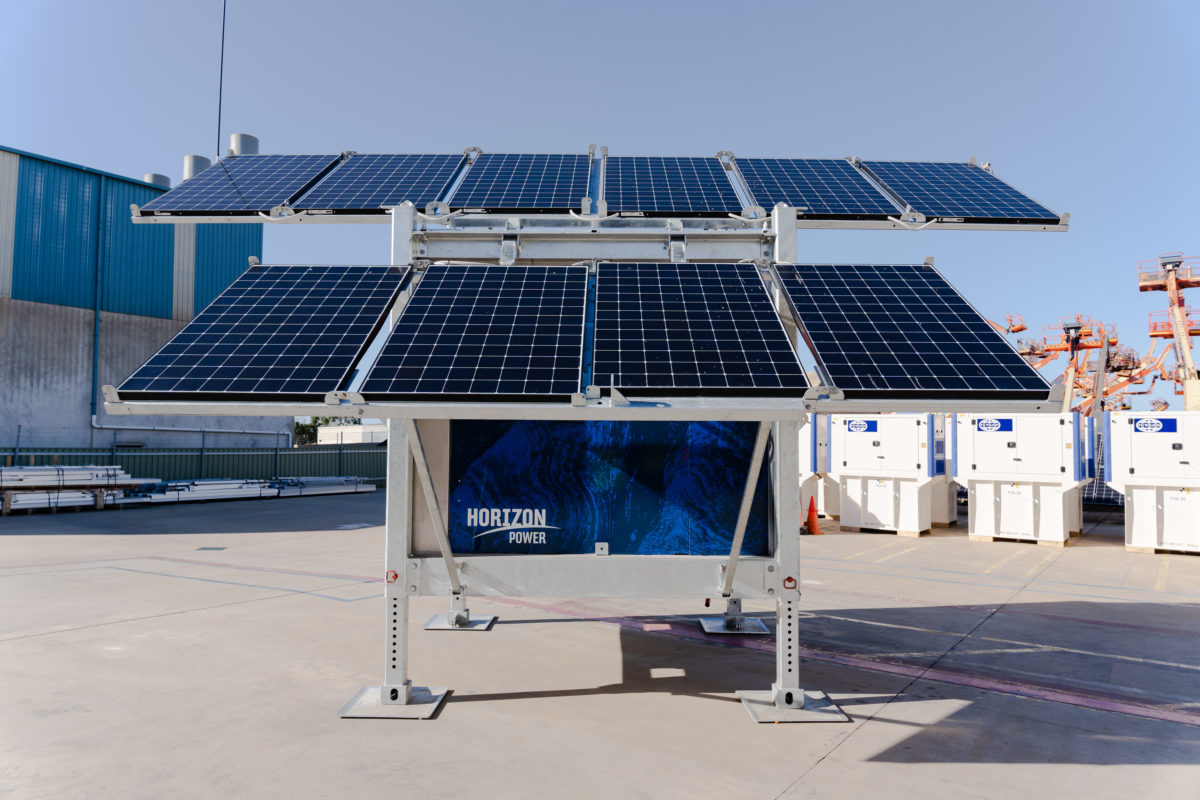Last month Boundary Power, the joint venture between West Australian Government-owned Horizon Power and east-coast, Newcastle-based, globally recognised electrical control solutions provider Ampcontrol hadn’t even turned one year old when it scooped design, innovation, and manufacturing awards for its standalone power systems (SAPS).
It is currently manufacturing and deploying some 50 customised SAPS in regional and remote WA, but in the new year it expects to jump the deserts of central Australia, cross the boundary into New South Wales and take that state’s strung out customers at the edges of the state’s grid by storm — dazzling them with the power of its reliable power supplies.
Reliability is the stand-out quality of the Boundary Power range of systems company Director Rod Henderson tells pv magazine Australia.
In October, Ampcontrol won the 2021 Hunter Manufacturing Award for Excellence in Product Design for Boundary Power’s Solar Cube, an integrated, foldout, solar-battery-generator combination that can be installed and providing electricity within 90 minutes of hitting the ground.
The clever Cube also took out the prestigious 2021 Australian Good Design Award for the Engineering Design of its Solar Cube. And Boundary Power shone at the WA Energy Awards, winning the Energy Innovation of the Year for its entire range — Nano SAPS, Solar Cube, R-series SAPS and Kiosk SAPS — of standalone solutions.
Providing utility-grade power
All that celebrated innovation and excellence is channeled into reliability and safety of systems that must provide utility-standard energy supply to homes, businesses and communities at the edges or beyond the reach of Australia’s stretched grids.
As Henderson points out, if rooftop solar in the suburbs stops working for some reason, those properties are connected to the grid, “but in the case of our standalone power supplies, they’re the only energy source those consumers have, so the right technology, the right components, the right partnerships are all-important aspects of our designs”.
He also cites Horizon Power’s flexibility, as a government trading entity, to enter into a partnership with a private company as one of the true innovations behind Boundary Power: “You know that’s innovative thinking led by Stephanie Unwin. It makes a big difference when you’re working with people who are really on the front foot,” he says of the unique arrangement.
In 2018, when Ampcontrol was in the process of acquiring CPS National, a company providing SAPS to telcos, utilities, resources companies and the rail sector in remote areas of Australia, Horizon Power was seeking to address the risks, cost and reliability of providing energy to its most far-flung customers.
After the fires in WA in 2015, ageing electricity infrastructure was identified as one potential spark for disaster, the cost of providing and maintaining new infrastructure at remote homesteads and agribusinesses was prohibitive, so Horizon Power investigated the viability of a renewables-led solution and found it promising.
It approached Ampcontrol, with its new CPS subsidiary, to tender for the supply of the first 17 proposed Horizon Power SAPS, but quickly decided that a separate venture combining Ampcontrol engineering expertise with Horizon Power’s energy-utility expertise and customer understanding could have a great future in the transitioning Australian energy scene.
Supplying regional customers with a variety of needs and ambitions
“We sat down with Horizon engineers and analysed many of their customers’ needs, we looked at their electrical loads,” says Henderson, who is also CEO and Managing Director of Ampcontrol, in order to come up with the range of capacities now in Boundary’s product offering.
They include the small-load generation supplied by Nano SAPS to power water pumps, electric fences and small dwellings, up to the modular extendability of Kiosk SAPS that deliver up to 120 kW of three-phase power from a 239.4kWp – 319.2kWp solar array and up to 310 kWh of battery storage.

Boundary Power
The initial 17 SAPS delivered to regional Western Australia proved a hit with recipients: some farmers celebrated not having to plough and harvest around electricity poles; other remote customers were enabled by the improvement in electricity supply from their new hybrid solar-battery-generator system.
“The the single-wire earth return, or the SWER system, that a lot of these customers were previously on was developed in the middle of last century,” says Henderson, “and the electrical loads that customers have now are obviously very different to what they were 60 or 70 years ago, so the system had not been meeting their needs.”
To now have the reliability of a generation source that can run chillers or a three-phase welder, and air-conditioning, as well as power electronics for charging phones and running TVs, was a revelation to many.
Reliability of power supply, Henderson feels, will open opportunities for new enterprises in the regions, and the SAPS, maintained by Horizon Power, and charged out at a kilowatts-consumed rate the same as if they were being served from the grid, are scalable to provide for growing businesses; businesses which are now primarily powered by renewables.

Boundary Power
Working towards diesel-free hybrid SAPS
In 2019, Horizon Power estimated that a diesel generator working in tandem with suitably sized solar and battery, and programmed to kick in when renewable energy sources are exhausted, would operate for fewer than 500 hours a year, delivering a carbon reduction on gas-generated energy from the grid.
Since then the government-owned utility has set a 2025 cut-off date for the addition of any new diesel generation to power its customers, and Boundary Power is investigating alternative backup generation, including a number of green-hydrogen-fuelled technologies.
In July, Boundary Power announced a new strategic partnership with hydrogen technology company LAVO and Ampcontrol, which it said would develop power solutions for remote energy users, data centres, and energy-intensive industries.
Alan Yu, LAVO’s Chief Executive Officer, said at the time, “LAVO’s hydrogen storage technology is ideally suited for integration with remote standalone power systems and for other containerised and mobile power solutions.”
As Boundary Power now rolls out a further 45-50 SAPS in the Esperance and Kimberley regions as part of the Western Australian Government’s $5 billion WA Recovery Plan, it has its eye on efforts in Australia’s eastern states to change utility regulations to allow electricity retailers there to also meet customer needs with SAPS where appropriate.
“It’s just getting through the legislation process, and New South Wales is very close — if we don’t see that before the end of this calendar year we’ll see it very early in the new year,” says Henderson, “and it’s on the drawing boards for Victoria, Queensland and South Australia to come online over the next few years as well.”
In a 2020 report by the Australian Energy Market Commission — Updating the regulatory frameworks for distributor-led standalone power systems — Essential Energy in NSW said it had identified some 2,000 customers for whom SAPS could represent the lowest-cost to serve; and AusNet Services in Victoria said it may be economic to deploy SAPS solutions for between 300 and 400 of its customers in bushfire-prone areas.
Solving old problems, targeting new markets
Boundary Power will likely target export markets sometime after successful SAPS deployments on the east coast of Australia, with Ampcontrol’s network of sales offices and agents ready to assist the deployment of these Australian standalone, low-carbon energy solutions into Southeast Asia and the Pacific Rim.

Boundary Power
“I think we have a very competitive, well placed product in that space,” says Henderson, who adds, “For Fiji and other Pacific nations that are prone to cyclones and the like, we have a high-quality, well-engineered, reliable, tested and certified product.”
At the same time, Ampcontrol subsidiary CPS National is working to solve the ongoing challenge of providing remote communities with clean water. The company has developed and installed its first two systems — one near Alice Springs and the other in the East Pilbara — that integrate water treatment with reliable, renewably powered SAPS.
“There are up to 300 communities in the Northern Territory alone that don’t have access to clean drinking water,” Henderson says, and CPS National “has a cost effective solution. We need governments to get behind it to make sure that they’re giving all our citizens access to what is a basic human need”.
Henderson has taken but a brief moment to bask in the sunny glow of Boundary Power’s awards bonanza. He says, “We have fantastic engineers on both sides of the Boundary Power equation, and the awards are due credit for those teams who have worked so hard to get these terrific outcomes.”
This content is protected by copyright and may not be reused. If you want to cooperate with us and would like to reuse some of our content, please contact: editors@pv-magazine.com.









2 comments
By submitting this form you agree to pv magazine using your data for the purposes of publishing your comment.
Your personal data will only be disclosed or otherwise transmitted to third parties for the purposes of spam filtering or if this is necessary for technical maintenance of the website. Any other transfer to third parties will not take place unless this is justified on the basis of applicable data protection regulations or if pv magazine is legally obliged to do so.
You may revoke this consent at any time with effect for the future, in which case your personal data will be deleted immediately. Otherwise, your data will be deleted if pv magazine has processed your request or the purpose of data storage is fulfilled.
Further information on data privacy can be found in our Data Protection Policy.